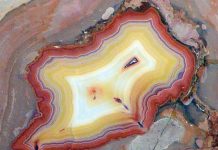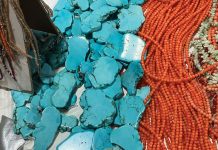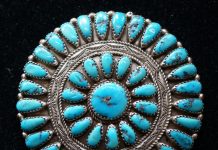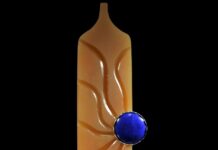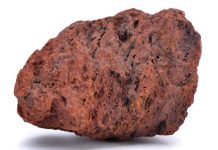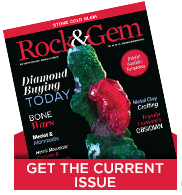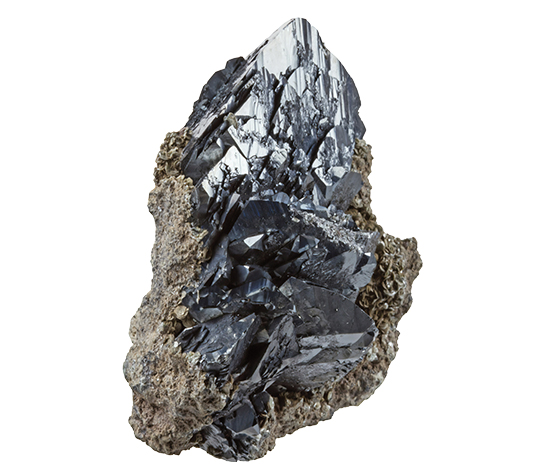
The iron oxide hematite mineral has an amazing history that began maybe 100,000 years ago, even before ancient cave people used its vivid reddish color to render drawings of the animals on cave walls. When crushed to a powder, normally black hematite exhibits a lovely red color. We use hematite’s red powder streak to identify it.
It seems odd that a normally black mineral has a name based on the Greek word haimatites, which means “blood-like.” But when streaked on a piece of unglazed tile, a reddish streak illustrates the origin of the name. More obvious are the specimens of hematite with a curving ball-like surface, decidedly reddish surface color, and shaped like a human kidney. English miners even took to calling it kidney ore.
Hematite’s Early Importance
Ancient cave artists would crush the hematite mineral into a red powder and use a straw-like tube to blow it into the porous rock to create artistic images. This same powdered hematite was also smeared on the face and body as “paint” for war and decoration.
How Hematite Forms
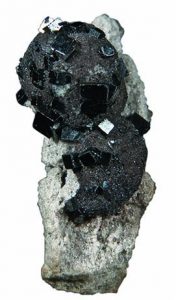
Hematite (Fe2O3) is the most common and most important of the several iron oxides. It forms lovely shiny black hexagonal crystals that can be clustered like the petals of a flower. It can also form velvety needle coatings and long curving splintery shapes. In addition, when included with other minerals, hematite’s lovely red color is even more apparent.
When one iron and one oxygen join iron oxide’s composition we call it magnetite (Fe3O4), which develops in the isometric or cubic system. Hematite is hexagonal. Combined with the OH radical, it forms goethite, hydrous iron oxide, and when hematite forms a pseudomorph after magnetite, we call it martite.
Hematite, with its different crystal forms in the hexagonal system, is deserving of serious collecting. It is not unusual for a collector to choose one species, like quartz, calcite, or smithsonite, and specialize in that one species. Hematite as a single collectible mineral is fun because of its many variations of crystal forms and worldwide sources.
The most sought-after form of hematite is sharp, lustrous tabular crystals that develop as a radiating flower-like crystal rosette several inches across. It’s not uncommon for these species to command high prices, as the rosettes are undoubtedly the most popular hematite crystal specimens. However, hematite can also form as tiny micaceous crystals that cover a matrix that is called specularite.
Hematite Mineral Varieties
Hematite can be platy, thin, micaceous, massive, mammillary, stalactitic, scalenohedral, reniform, botryoidal, splintery, oolitic and even present as large, sharp hexagon crystals.
Though hematite is made of iron and oxygen, it is not magnetic when pure. But it can fool you because it can contain a little magnetite, which, as discussed earlier, is the magnetic form of iron oxide. With this, testing hematite with a magnet can give misleading results.
Another interesting thing about hematite is the variety of associated names. Hematite locked in greenish silica as visible red spots is often called bloodstone. When lovely tabular crystals arrange themselves in a radiating pattern that looks organic, we refer to it as iron rose.
Botryoidal and reniform hematite will often have a dull, reddish color on their surface, which led miners to call them kidney ore. Furthermore, hematite has actually been used as a gemstone in spite of a hardness that ranges only 5 to 6 on the Mohs scale of hardness. When very compact, hematite in solid masses has been carved to form pendant stones and cameos that take a fairly high polish. They cannot take too much contact, but can be used as an alternative to jet, the hardened gem form of anthracite coal.
Hematite’s Role In Early Civilization
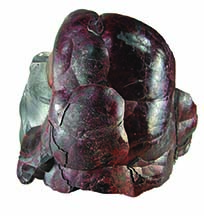
Hematite has been our most important source of iron for the past centuries, but to King Tut, iron was a virtual unknown. The only iron at that time had come from meteorites, as evidenced by a meteoric dagger found in the king’s tomb.
Gradually, people of the Near East and China moved from the Copper Age to the Bronze Age, which ruled the world for centuries. Then the Hittites, an advanced people of the Near East, emerged in the 18th century B.C. as a dominant civilization because they had developed a metal harder than bronze: iron. They discovered how to produce iron weapons from iron oxide hematite, and the all-important Age of Iron began.
Fortunately, we have found huge deposits of hematite all over the world. Countries including Brazil, Africa, Australia, Russia, and the U.S., including the Midwest and Alabama, specifically, have vast deposits of iron oxide. It’s also not limited to our planet alone. Mars is called the Red Planet because of the proven presence of its iron oxide surface, derived from hematite.
Hematite in America’s Upper Midwest
America’s Upper Midwest is a superb example of a vast iron oxide deposit that stretches over a couple of states and has been mined constantly for well over 100 years. This sedimentary deposit contains miles and miles of banded hematite and related iron compounds in layer after layer that is hundreds of feet thick. It certainly did not form from the welling up of hydrothermal intrusion of complex iron compounds, as so many metal deposits have. Granted, the Earth’s core is mostly iron, but the vast iron oxide deposits in the Earth’s crust had another origin: an organic origin called cyanobacteria living in an early iron-rich ocean.
Cyanobacteria are a simple-celled, organic form that evolved in the warm, shallow seas billions of years ago. It was the first organism to develop the ability to absorb carbon dioxide from the atmosphere through what is known as the process of photosynthesis. This produced oxygen.
Evolution of Hematite Mineral Deposits
But how did that result in the huge hematite iron deposits we mine today? Everyone knows that iron and oxygen in a moist environment form rust (iron oxide). It so happens that those same warm ocean waters were rich in iron. As cyanobacteria produced quantities of oxygen, an instant marriage between iron in the ocean waters and oxygen formed vast quantities of hematite, which settled to the ocean floor, millennia after millennia, to create the rich iron deposits later used to initiate the Iron Age.
But Mother Nature was not finished. She gave us the means to move into the Iron Age by supplying the necessary ingredients to make steel. In those early millennia, the North American continent was nearly covered by warm, shallow seas and the Midwest region was blessed with vast deposits of iron oxide. Those same oceans also left behind thick layers of limestone, which were not too far away from vast forests that developed in a warm, moist climate. When these forests died, they became thick layers of rotting and compressed vegetation that eventually formed huge deposits of coal.
Hydrothermal Minerals
Mother Nature’s next stroke was to inject hydrothermal solutions rich in minerals, including fluorite, into the limestone within the central United States. This resulted in hematite, coal, limestone, and fluorite being present in the general area of the Midwest. This helped set the stage for the growth of America’s Age of Steel.
However, one additional thing was needed: a way to bring all these things together. Enter the glaciers! Nature helped when it added Great Lakes, such as Lake Michigan, and great rivers as inexpensive avenues to bring these natural ingredients together, making the Midwest one of the most prolific steel-making regions in the world. It also gave way to fine hematite, fluorite, and limestone quarry collecting sites.
Within the Mesabi range of Minnesota, we find fascinating hematite in long, slender, curving splinters that can split into dagger-like pieces. Few exceptional crystallized hematite specimens have come from the mines of the Mesabi Range. But superb fluorite, calcite, pyrite, celestine, and a host of other species have.
Hematite Mineral: European Connections
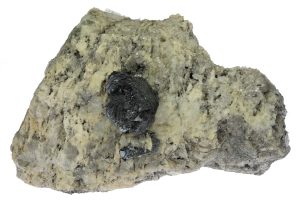
The mountains of Southern Europe, especially the rugged Swiss Alps, are world-renowned for superb hematite mineral specimens. Swiss mineral collectors, known as stralters, work the rugged hills for brilliant, bright black rosettes of hematite. They range in size from under an inch to several inches across, often with bright red rutile crystals sprinkled on shiny black crystal faces. The North Polar region of Russia also yield superb hematite rosettes very much like the Swiss specimens, along with axinite and gwindel quartz twins.
One of the great classic hematite sources is Elba, Italy, where Napoleon reportedly enjoyed leisure time. The hematite crystals from this region are hexagonal with slightly curving prism faces. Appearing in interlocking clusters, they sometimes were found penetrating bright pyritohedron pyrite crystals that developed simultaneously with the hematite. The pyrite crystals often exceed several inches across, with hematite crystals in tight interlocking clusters. Today, the hematite and pyrite specimens from the Island of Elba, Italy, are considered classics.
Hematite Mineral: Great Britain
In another part of the world, the great iron and copper mines of Cumberland, now Cumbria, England, certainly met the needs of the British Industrial Revolution. Lovely, tiny hematite blades in tight clusters on the matrix are common in this part of the world. They are often associated with quartz, sometimes with bright red iron oxide inclusions in the quartz crystals. Just as well-known are the large masses of botryoidal hematite, many inches across and many pounds in weight. These are composed of spherules of hematite needles, which form radiating knobs that interfere with each other to form the undulating smooth surface of mammillary specimens. Some of these large pieces are covered with tiny, bright specularite hematite crystal blades. Most of these massive hematites are a lustrous black, while still others present as a reddish color to form kidney ore.
Hematite Mineral: Worldwide Connections
The huge iron ore deposits of Brazil are also well-known to collectors who prize the superb tabular hematite crystals from Brumado, Novo Horizonte, Itabiria, Con Genar de Campo, and Jaguarcu. Bright, lustrous platy crystals, sometimes exceeding five inches across, are found here. Some crystals are pyramidal, scalenohedral or rhombohedral.
Collectors who are in love with the superb rhodochrosite specimens from the Black Rock manganese area of South Africa also enjoy fine prismatic and pyramidal hematite crystals from the Wessels mine, Hotazel. They are lustrous and sharp in well-formed crystals. Further north are the hematite deposits of Mador Pror, Morocco, where fine-bladed crystals are relative newcomers in the mineral market.
Hematite Mineral: Conclusion
Whether admired for its metallic luster, valued for its rich iron content, or revered for its historical significance, the hematite mineral continues to captivate geologists, collectors, and artists alike. Its presence across cultures and continents underscores its geological importance and enduring appeal. As both a scientific marvel and a visual treasure, the hematite mineral stands as a testament to the beauty and complexity found within the Earth’s crust.
This article exploring the hematite mineral previously appeared in Rock & Gem magazine. Click here to subscribe. Story by Bob Jones.


